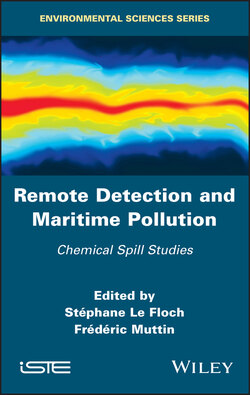Читать книгу Remote Detection and Maritime Pollution - Группа авторов - Страница 2
Table of Contents
Оглавление1 Cover
2 Title page
3 Copyright
4 Forewords
5 PART 1: Remote Sensing Means 1 POLLUPROOF Project 1.1. Introduction 1.2. POLLUPROOF project 1.3. Experimental approach 1.4. Conclusion 1.5. References 2 Multifrequency Radar Imagery and Characterization of Hazardous and Noxious Substances at Sea 2.1. Introduction 2.2. Experimentation at sea 2.3. Methodology 2.4. Results and discussion 2.5. Conclusion 2.6. Acknowledgments 2.7. References 3 Remote Sensing of HNS using Longwave Infrared Hyperspectral Imaging 3.1. Introduction 3.2. LWIR hyperspectral remote sensing capability 3.3. Detection and identification of HNS using LWIR hyperspectral sensing 3.4. Conclusion 3.5. References
6 PART 2: Remote Sensing to Support Marine Surveillance Services 4 Customs Expertise in Remote Sensing 4.1. Introduction 4.2. The aircraft 4.3. The equipment 4.4. Airborne remote sensing processing 4.5. Side-looking airborne radar (SLAR) processing 4.6. Infrared and ultraviolet line scanner 4.7. Standard detection and investigation 4.8. The future, a new multi-mission aircraft 5 Remote Sensing as Evidence in Court 5.1. Introduction 5.2. Legal framework of the offence and the evidence 5.3. Remote sensing: questions and advances 5.4. Conclusion 5.5. References 6 Long-Term Surveillance and Monitoring of Natural Events in Coastal Waters 6.1. Introduction 6.2. Satellite products for long-term surveillance 6.3. Some specific events of natural origin in coastal waters 6.4. Conclusion 6.5. References
7 PART 3: Remote Sensing to Support the Response Strategy 7 VIGISAT Ground Receiving Station and EMSA CleanSeaNet Services 7.1. Introduction 7.2. VIGISAT ground receiving station and detection of pollution in near-real time 7.3. Polluter identification with AIS data flows and drift modeling 7.4. References 8 System-to-system Interface Between the EMSA CleanSeaNet Service and OSERIT 8.1. Introduction 8.2. The EMSA CleanSeaNet service 8.3. OSERIT 8.4. A system-to-system interface between CleanSeaNet and OSERIT 8.5. The Flinterstar incident 8.6. Conclusion 8.7. Acknowledgments 8.8. References 9 Optimizing the Use of Aerial Surveillance Assets in Oil Spill Response Operations 9.1. Introduction 9.2. Assumptions and working hypotheses 9.3. Experimental protocol: testing the primary hypothesis 9.4. Experimental protocol: underlying assumptions and testing of secondary hypothesis 9.5. The case for using SUAS as a force multiplier in spill response coordination 9.6. Appendix 1 9.7. Appendix 2 9.8. References
8 PART 4: Remote Sensing for Exploration 10 Potential of Imaging UAVs for Coastal Monitoring 10.1. Introduction 10.2. Constraints on the survey 10.3. Examples of UAV platforms 10.4. Survey protocol 10.5. Data processing 10.6. Examples of applications 10.7. Conclusion 10.8. References 11 Use of Remote Sensing Techniques to Survey, Detect and Interpret Hydrocarbon Seeps and Spills for Exploration and Environment 11.1. Introduction 11.2. Methodology 11.3. Offshore facilities monitoring/mining field 11.4. Emergency 11.5. Perspectives 11.6. Conclusion 11.7. References 12 Natural Escapes of Oil in Sedimentary Basins: Space-borne Recognition and Pairing with Seafloor and Sub-seafloor Features 12.1. Introduction 12.2. Datasets and methods 12.3. Results 12.4. Conclusion 12.5. References
9 Conclusion
10 List of Authors
11 Index
12 End User License Agreement
